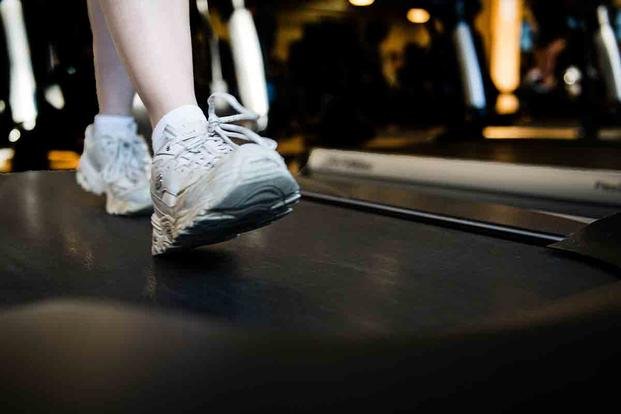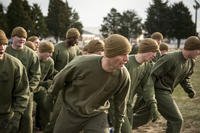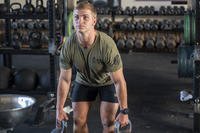The term "microdosing" is usually associated with areas of medicine and research, but applying this concept to fitness is nothing new, especially if you have a home gym or door jamb pull-up bar in your home or office. Microdosing might not be the best name for it ("microfitness" or "mini-workouts" might), but we're talking about doing quick workouts to maintain fitness levels when you don't have time to get to a full gym or to do a full workout.
Cranking out quick sets throughout the day is a great way to wake up and stay productive, and you may have done some microfitness already and not even realized it. How many of you put up a new pull-up bar in the house and promised to do a few pull-ups every time you walked past? You can accumulate the same number of pull-ups as you would have in a typical upper-body workout. That's just one way to do this type of training.
Another way is to do a five- to 10-minute, nonstop, high-intensity training circuit. For instance, I will often walk past my bench press and do a max-rep set of 135 pounds, then follow it up with a max set of pull-ups. My rest is walking to the end of my driveway and back, and then I repeat that two-exercise circuit until my time limit is up. Usually, I can get 3-5 sets in a 10-minute window and a killer upper-body pump in the chest, shoulders, arms and back. It feels like I did something.
Benefits of Mini-Workouts
Many researchers have found these "microdosed workouts" beneficial, whether cardio-based High-Intensity Interval Training (HIIT) or one-set circuits. These fast-paced and higher-intensity workouts have been shown to increase VO2 max. A higher VO2 max typically equates to better cardiovascular health and wellness. A weekly routine featuring even a few HIIT sessions could have a long-term positive impact.
These quick workout segments will burn more than six times the calories burned if we continue to sit still. This can be the difference between weight loss or weight gain each week and help to push people into a caloric deficit. However, there is evidence that quick workouts help people maintain and improve in certain focused events, such as pull-ups and cardio events.

Quick Mini-Workouts for Busy Athletes
When the workdays are long and physically demanding, finding quick workouts to help you maintain your working strength and endurance is needed, especially if you are preparing to deploy into harm's way or are in the middle of a season of athletics. Steph Mock, assistant athletic director for sports performance at the University of Pittsburgh, uses microdosing workouts with athletes to help them manage hectic schedules and lack of time.
The school-day schedule, practices, competitions, travel, academic commitments and workouts for sports conditioning are being juggled by athletes and athletic staff alike. She emphasizes that "this methodology allows for more focused, specific stimulus in training sessions, aiding in better athlete preparation and recovery." Tactical athletes can do the same when time is short, and the days are long when workout options are minimal.
Mini-Workouts for Fitness Testing
A quick set of any exercise in a fitness test makes for a perfect example of how to mix in a "micro-workout" into your day. Doing it multiple times a day is better, but even one set of exercises, such as push-ups, sit-ups, plank or pull-ups, can go a long way to seeing improvements.
Half of the battle of fitness testing exercises is building up the endurance and muscle stamina to last a full two minutes (the typical PT test time). Spreading an exercise throughout the day in two-minute segments has allowed users to see improvements across the board in calisthenics-based training. Maybe adding volume to a week of training helps people see improvements, but one thing is for sure: Practicing these events regularly (every other day) will help you prepare for this type of fitness testing event.
One rule I would consider, however, is to make sure you have a normal split routine that you adhere to. Do not do the same exercises day after day; split them into upper- and lower-body days so you can recover from the added volume of training.
Mini-Workouts: Do They Work? See for Yourself
For those with busy schedules or those who want to add some workout volume to each day, try it for yourself. All types of exercisers have seen benefits from the busy work from home entrepreneurs to tactical athletes and in-season sports athletes. Mini-workouts offer a convenient way to maintain strength and endurance. These short bursts of exercise can provide specific stimulus in training, helping with fitness testing events. By practicing these events regularly, individuals can better prepare for the rigors of fitness testing and create testing strategies to help with such test-taking events.
In short, incorporating mini-workouts into your routine can significantly impact your overall fitness and well-being. So why wait? Start integrating mini-workouts into your day and reap the benefits of improved health and performance.
Stew Smith is a former Navy SEAL and fitness author certified as a Strength and Conditioning Specialist (CSCS) with the National Strength and Conditioning Association. Visit his Fitness eBook store if you're looking to start a workout program to create a healthy lifestyle. Send your fitness questions to stew@stewsmith.com.
Want to Learn More About Military Life?
Whether you're thinking of joining the military, looking for fitness and basic training tips, or keeping up with military life and benefits, Military.com has you covered. Subscribe to Military.com to have military news, updates and resources delivered directly to your inbox.





















